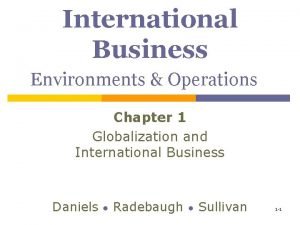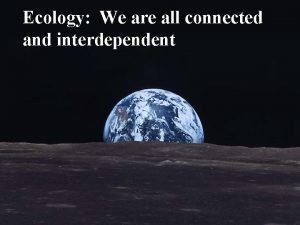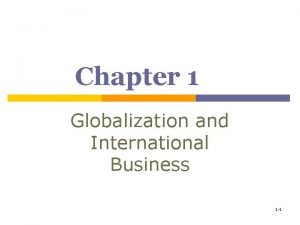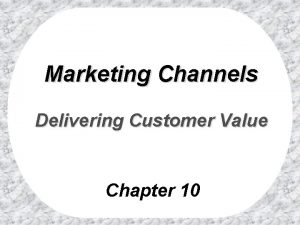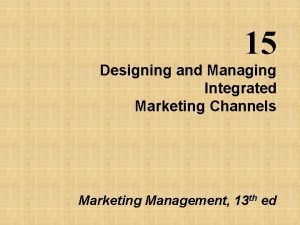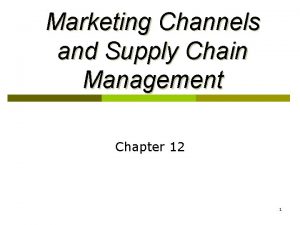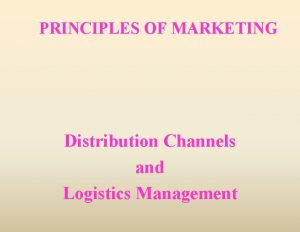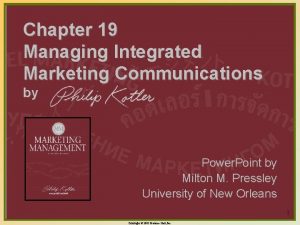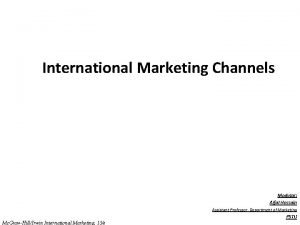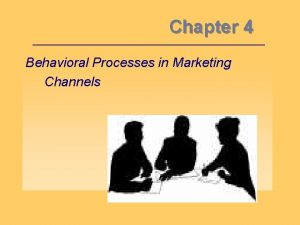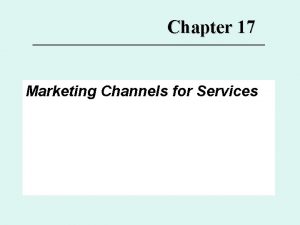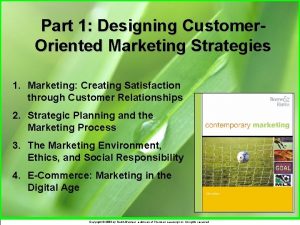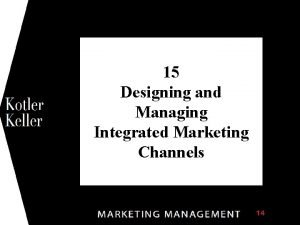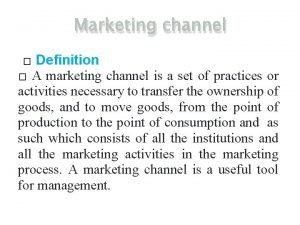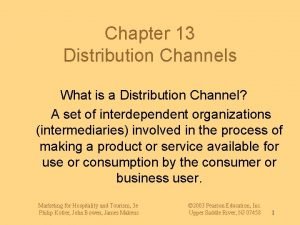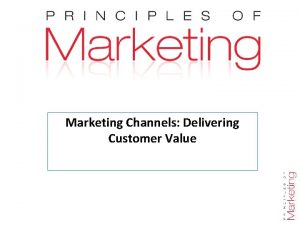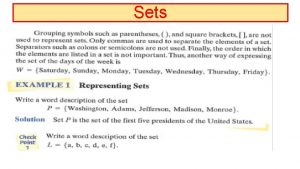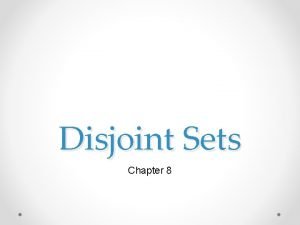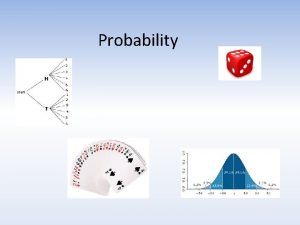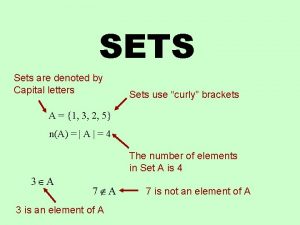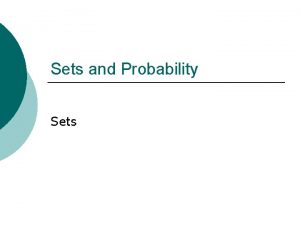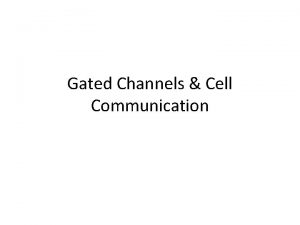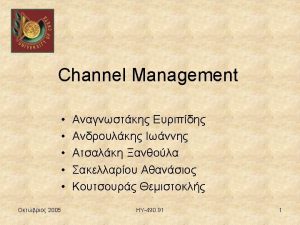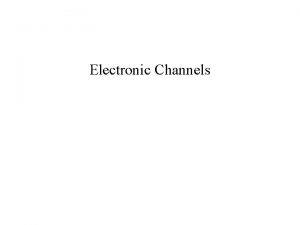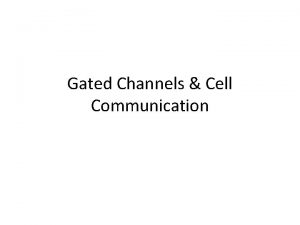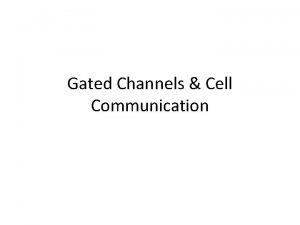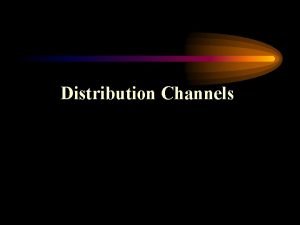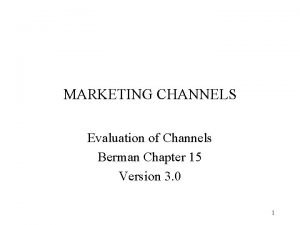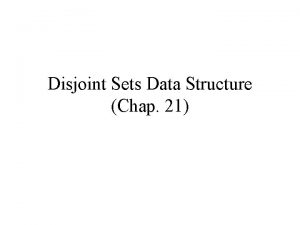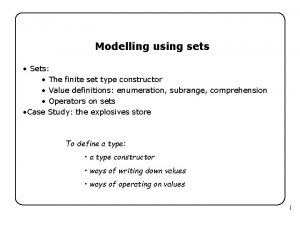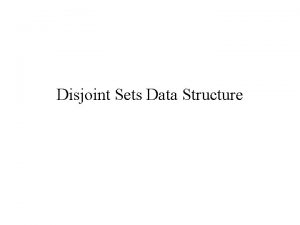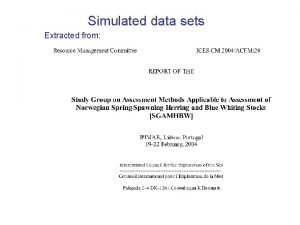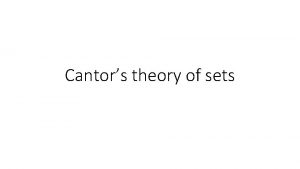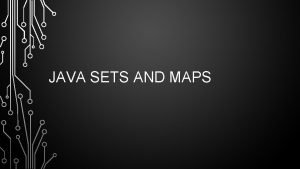a Marketing Channels Marketing Channels Sets of interdependent






































- Slides: 38

8 a Marketing Channels

Marketing Channels Sets of interdependent organizations involved in the process of making a product or service available for use or consumption. Professor Takada 8 a-2

Channels and Marketing Decisions Push Strategy Pull Strategy Professor Takada 8 a-3

Categories of Buyers Habitual shoppers High value deal seekers Variety-loving shoppers High-involvement shoppers Professor Takada 8 a-4

Buyer Expectations for Channel Integration • Ability to order a product • • online and pick it up at a convenient retail location Ability to return an onlineordered product to a nearby store Right to receive discounts based on total online and offline purchases Professor Takada 8 a-5

e-Commerce Marketing Practices • Pure-click • Brick-and-mortar Professor Takada 8 a-6

Should the 4 P’s be replaced? • Solutions • Information • Value • Access Professor Takada 8 a-7

ROAD MAP: • Why do companies use distribution channels? The functions these channels perform. • How do channel members interact and organize to perform the work of the channel? • Identify the major channel alternatives open to a company. • How do companies select, motivate, and evaluate channel members? • Marketing logistics and supply chain management. Professor Takada 8 a-8

ROAD MAP: • Why do companies use distribution channels? The functions these channels perform. • How do channel members interact and organize to • • • perform the work of the channel? Identify the major channel alternatives open to a company. How do companies select, motivate, and evaluate channel members? Marketing logistics and supply chain management. Professor Takada 8 a-9

Marketing or Distribution Channel • A set of interdependent organizations involved in the process of making a product or service available for use or consumption by the consumer or business user. How Channel Members Add Value • The use of intermediaries results from their greater efficiency in • making goods available to target markets. Offers the firm more than it can achieve on its own through the intermediaries: – – Contacts Experience Specialization Scale of operation Professor Takada 8 a-10

A Distributor Reduces the Number of Channel Transactions Professor Takada 8 a-11

Channel Member Functions • Gather information • Develop and disseminate persuasive • • • communications Reach agreements on price and terms Acquire funds to finance inventories Assume risks Provide for storage Provide for buyers’ payment of their bills Oversee actual transfer of ownership Professor Takada 8 a-12

Marketing Channel Flows Professor Takada 8 a-13

Consumer Marketing Channels Professor Takada 8 a-14

Industrial Marketing Channels Professor Takada 8 a-15

ROAD MAP: • Why do companies use distribution channels? The functions these channels perform. • How do channel members interact and organize to perform the work of the channel? – Channel Behavior – Vertical Marketing Systems (VMS) • Corporate VMS • Contractual VMS-Franchise Organization • Administered VMS – Horizontal Marketing Systems • • • Identify the major channel alternatives open to a company. How do companies select, motivate, and evaluate channel members? Marketing logistics and supply chain management. Professor Takada 8 a-16

Channel Behavior • The channel will be most effective when: – each member is assigned tasks it can do best. – all members cooperate to attain overall channel goals. • If this does not happen, conflict occurs: – Horizontal Conflict • occurs among firms at the same level of the channel – (e. g. , retailer to retailer). – Vertical Conflict • occurs between different levels of the same channel – (e. g. , wholesaler to retailer). • Some conflict can be healthy competition. Professor Takada 8 a-17

Conventional vs. Vertical Marketing System Professor Takada 8 a-18

Types of Vertical Marketing Systems Corporate VMS Common Ownership at Different Levels of the Channel (Sears) High Contractual VMS Contractual Agreements Among Channel Members (ACE Hardware) Administered VMS Leadership Assumed by One ora Few Dominant Members (Kraft) Professor Takada Control Low 8 a-19

Franchise Organization • Manufacturer-Sponsored Retailer Franchise System – Ford and its independent franchised dealers • Manufacturer-Sponsored Wholesaler Franchise System – Coca-Cola’s licensed bottlers • Service-Firm Sponsored Retailer Franchise System – Mc. Donald’s, Avis, and Holiday Inn Professor Takada 8 a-20

Innovations in Marketing Systems Horizontal Marketing System Hybrid Marketing System Two or more companies at one channel level join together to follow a new marketing opportunity. Example: Banks in grocery stores Professor Takada A single firm sets up two or more marketing channels to reach one or more customer segments. Example: Retailers and catalogs 8 a-21

Changing Channel Organization • Disintermediation – Product and service producers are bypassing intermediaries and going directly to final buyers – Radically new types of channel intermediaries are emerging to displace traditional ones. Expedia, Travelocity, Priceline, Hotels. com, and Orbitz versus traditional travel agents. Professor Takada 8 a-22

ROAD MAP: • Why do companies use distribution channels? The functions • these channels perform. How do channel members interact and organize to perform the work of the channel? • Identify the major channel alternatives open to a company. – Channel Design Decisions: • Analyze consumer needs, set channel objectives, identify major alternatives, and evaluate the major alternatives. • How do companies select, motivate, and evaluate channel • members? Marketing logistics and supply chain management. Professor Takada 8 a-23

Channel Design Decisions • Analyze Consumer Needs • Set Channel Objectives • Identify Major Alternatives – Types of intermediaries • Company sales force • Manufacturer’s agency • Industrial distributors – Number of intermediaries • Intensive distribution • Exclusive distribution • Selective distribution • Evaluate the Major Alternatives – Economic Criteria: • A company compares the likely sales, costs, and profitability of different channel alternatives. – Control Issues: • How and to whom should control be given? – Adaptive Criteria: • Consider long-term commitment vs. flexibility. Professor Takada 8 a-24

Identifying Channel Alternatives Types of intermediaries Number of intermediaries Terms and responsibilities Professor Takada 8 a-25

Number of Intermediaries Exclusive Selective Intensive Professor Takada 8 a-26

The Value-Adds Versus Costs of Different Channels Professor Takada 8 a-27

Break-Even Chart for the Choice Between A Company Sales Force and Manufacturer’s Sales Agency Professor Takada 8 a-28

ROAD MAP: • Why do companies use distribution channels? The • • functions these channels perform. How do channel members interact and organize to perform the work of the channel? Identify the major channel alternatives open to a company. • How do companies select, motivate, and evaluate channel members? – Channel Management Decisions • Marketing logistics and supply chain management. Professor Takada 8 a-29

Channel Management Decisions Selecting Channel Members Managing & Motivating Channel Members Evaluating Channel Members Professor Takada 8 a-30

Channel Power • • • Coercive Reward Legitimate Expert Referent Professor Takada 8 a-31

Managing Channel Conflict • Adoption of • • superordinate goals Cooptation Diplomacy Mediation Arbitration Professor Takada 8 a-32

Public Policy and Distribution Decisions • Exclusive distribution • Exclusive dealing • Exclusive territorial agreements • Tying agreements Professor Takada 8 a-33

ROAD MAP: • Why do companies use distribution channels? The functions • • • these channels perform. How do channel members interact and organize to perform the work of the channel? Identify the major channel alternatives open to a company. How do companies select, motivate, and evaluate channel members? • Marketing logistics and supply chain management. Professor Takada 8 a-34

Logistics and Supply Chain Management • Planning, implementing, and controlling the physical flow of goods, • services, and related information from points of origin to points of consumption to meet customer requirements at a profit. Includes: – Outbound distribution – Inbound distribution – Reverse distribution Professor Takada 8 a-35

Major Logistics Functions • Warehousing – – How many, what types, and where? Storage warehouses Distribution centers Automated warehouses • Inventory management – Must balance between too much and too little inventory. – Just-in-time logistics systems – RFID, Auto. ID, or Smart Tag technology • Transportation – Trucks, railroads, water carriers, pipelines, air, Internet, intermodal transportation • Logistics information management Professor Takada 8 a-36

Integrated Logistics Management • The logistics concept that emphasizes teamwork, • both inside the company and among all the marketing channel organizations, to maximize the performance of the entire distribution system. Involves: – Cross-functional teamwork inside the company – Building logistics partnerships – Third-party logistics • Ryder Integrated Logistics Professor Takada 8 a-37

Rest Stop: Reviewing the Concepts 1. Explain why companies use distribution channels 2. 3. 4. 5. and discuss the functions these channels perform. Discuss how channel members interact and how they organize to perform the work of the channel. Identify the major channel alternatives open to a company. Explain how companies select, motivate, and evaluate channel members. Discuss the nature and importance of marketing logistics and integrated supply chain management. Professor Takada 8 a-38
 3 v's of concentrix
3 v's of concentrix Interdependent
Interdependent International business and globalisation
International business and globalisation Connected and interdependent
Connected and interdependent Globalization in international business
Globalization in international business Marketing channels delivering customer value
Marketing channels delivering customer value Direct marketing channel
Direct marketing channel Designing and managing integrated marketing communications
Designing and managing integrated marketing communications The distribution objective must be congruent with:
The distribution objective must be congruent with: Vertical
Vertical Channel captain marketing
Channel captain marketing Distribution channels and logistics
Distribution channels and logistics Global marketing channels and physical distribution
Global marketing channels and physical distribution Designing and managing integrated marketing communications
Designing and managing integrated marketing communications Marketing mix channels of distribution
Marketing mix channels of distribution Foreign country middlemen
Foreign country middlemen Supply chain management and marketing channels
Supply chain management and marketing channels Designing and managing integrated marketing channels
Designing and managing integrated marketing channels Marketing channels and supply chain management
Marketing channels and supply chain management Behavioral processes in marketing channels
Behavioral processes in marketing channels Alternative marketing channels
Alternative marketing channels Who engages in channel design
Who engages in channel design Behavioral processes in marketing channels
Behavioral processes in marketing channels Marketing channels for services
Marketing channels for services Marketing environment framework
Marketing environment framework Specialty channels marketing
Specialty channels marketing Designing and managing integrated marketing channels
Designing and managing integrated marketing channels Integrated marketing channel system
Integrated marketing channel system Market channel definition
Market channel definition Marketing channel objectives
Marketing channel objectives Channel distribution
Channel distribution Chapter 12 marketing channels delivering customer value
Chapter 12 marketing channels delivering customer value Behavioral processes in marketing channels
Behavioral processes in marketing channels What is a marketing channel system and value network
What is a marketing channel system and value network Marketing channels and supply chain management
Marketing channels and supply chain management Five common flows across distribution channels
Five common flows across distribution channels Physical marketing channels
Physical marketing channels Marketing channels delivering customer value
Marketing channels delivering customer value Types of skills
Types of skills


